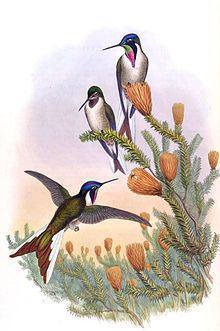Kingdom Animalia Genus Oreonympha
Gould, 1869 Phylum Chordata Rank Species | Family Trochilidae Scientific name Oreonympha nobilis Higher classification Oreonympha Order Apodiformes | |
 | ||
Similar Pirre hummingbird, Slender‑tailed woodstar, Mountain avocetbill, Peruvian piedtail, Short‑tailed woodstar | ||
The bearded mountaineer
The bearded mountaineer (Oreonympha nobilis) is a species of hummingbird in the family Trochilidae. It is found only in Peru. Its natural habitat is subtropical or tropical high-altitude shrubland.
Contents
The ornithologist John Gould described the species in 1869, from a specimen collected by H. Whitely at Tinta District, and placed it in its own genus Oreonympha. He recognised a kinship with Oxypogon and Ramphomicron. The genus name is derived from the Ancient Greek words oreo- "mountain" and "nympha" "nymph", while the specific epithet is the Latin adjective nobilis, "noble". A study of mitochondrial DNA of hummingbirds shows it to be most closely related to the bearded helmetcrest (Oxypogon guerinii) and the rufous-capped thornbill (Chalcostigma ruficeps). The other member of the genus Chalcostigma lay outside the group, suggesting the genus might need revising in the future. Two subspecies are recognised - the more widespread nominate subspecies nobilis has a blue eyebrow, while the more restricted albolimbata has white.
Measuring 15.5 to 16.5 cm (6.1 to 6.5 in) in length, it is a large hummingbird with a long tail and a 2.4 cm (0.94 in) long bill. The underparts of both sexes are white, while the tail is white underneath with black feather tips. The male has a green and purple throat. The upper parts are a bronze-sheened brown and the legs and bill are black.
The species is endemic to Peru, where it is found in high altitude valleys in the south-central Andes, from 2,700 to 3,900 m (8,900 to 12,800 ft). It lives in scrubland, and often visits tobacco (Nicotiana) plants along roadsides.
